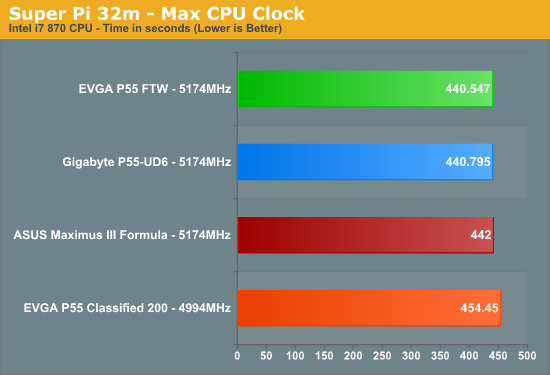P55 Overclocking Showdown - ASUS, Gigabyte, and EVGA at the OC Corral (Page 6 Updated)
by Rajinder Gill on November 6, 2009 12:00 PM EST- Posted in
- Motherboards
SuperPi 32M
32M is one of those benches one could waste an eternity in trying out various tweaks on both the board and in the operating systems. We decided to keep things short and simple for this review by optimizing the basic memory options and Bclk rates to show differences in how each board sets up sub-timings using the same processor and memory clocks on a given multiplier. All the boards managed the same 22x 234 BCLK using the 2:8 memory ratio.
ASUS trails by virtue of a very loose set of default sub timings. Unfortunately, we lost our ASUS ROG board to the Foxconn socket meltdown problem at this point. This also damaged our best CPU in the process so were unable to push further in this particular benchmark as our replacement processors did not clock as well.
The EVGA E659 did not fare as well as the other boards in this benchmark using the 2:10 memory ratio. No matter what we tried we could not get the board to pass 32M any higher than 226~227 BCLK in this bench. Moving over to the 2:8 ratio the E659 managed to out clock the other boards for raw CPU frequency. However, raw memory bandwidth and tight latencies favor this benchmark over the small differences in CPU frequency in our results so the lack of stability with the 2:10 memory ratio is adversely affecting the E659.











52 Comments
View All Comments
michael19 - Friday, November 6, 2009 - link
"Our test sample arrived with the revised Foxconn socket.."how can we tell if we have the revised foxconn socket as opposed to the defective version?
Rajinder Gill - Friday, November 6, 2009 - link
No idea at this point. Only Foxconn seem to know what it is they changed in the June revision.michael19 - Friday, November 6, 2009 - link
Or perhaps a side by side picture would show us some noticeable visual differences, possibly..cmdrdredd - Friday, November 6, 2009 - link
How come the Asus board is left out of the final few notes and tests? It's in the 3DMark and SuperPi scores etc, but there's individual pages dedicated to the other boards...Samus - Monday, November 9, 2009 - link
probably because it failed mid-testingAstroGuardian - Wednesday, November 11, 2009 - link
It's socket burned as a result of not so extreme overclock. It's not ASUS fault, it's Foxconn's faulty socketRajinder Gill - Friday, November 6, 2009 - link
Hi,The ASUS board died before I could complete the 750 retail CPU testing. We just got a new board last week so I will possibly update when that arrives here.
later
Raja
cmdrdredd - Friday, November 6, 2009 - link
lol well, a dead board spells trouble anyway IMO. Unless something drastic was done to it (extreme overclock for example).michael19 - Friday, November 6, 2009 - link
OK, thank you. Would the numbers on the backplate give us any indication? Is there any consistent difference in the numbers printed on the backplate from the old burnt out sockets to the new ones you have now?Corsairs - Friday, November 6, 2009 - link
I'd love to see this board compared to the group reviewed here.